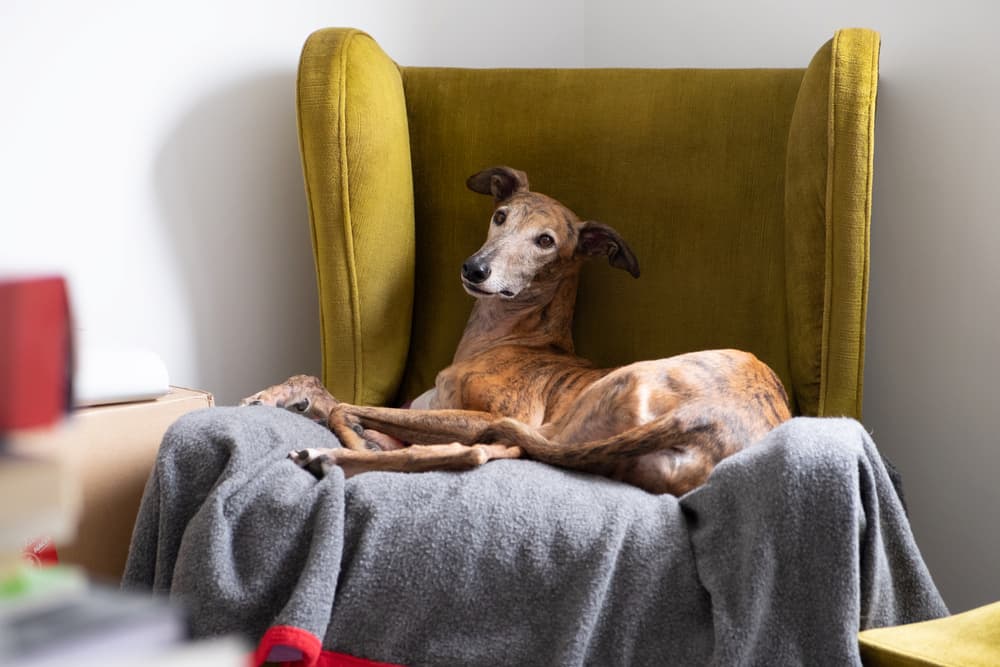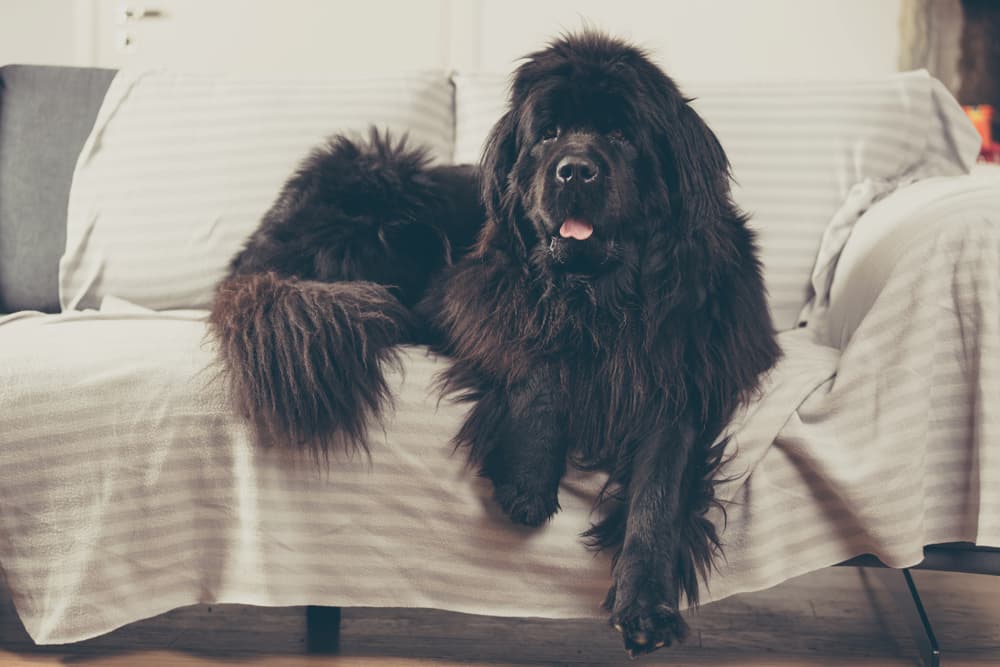8 Calm Dog Breeds for Peace and Quiet

Some pet parents want an active adventure buddy while others are looking for a doggo who is as cool as a cucumber. If you are searching for the latter, there are plenty of calm dog breeds out there that can meet your desire for a laid back, loyal companion.
“Like people, dogs are shaped by their background and their environment,” says Dr. Christopher W. Shapley, DVM CVA CVCH, who specializes in integrated medicine at NorthStar VETS Veterinary Emergency, Trauma, and Specialty Center in New Jersey. “While every dog is an individual, there are certain breeds that are more likely to be calm than others.”
Want to learn more about some of the best calm dog breeds? Keep reading!
8 Most Calm Dog Breeds
If you’re looking to add a calm canine to your family, here are eight chill breeds to consider.
Basset Hounds

Known for their big floppy ears and adorable sad eyes, Basset Hounds are also regarded as one of the most calm dog breeds out there.
Originating in France and Belgium, these dogs were bred to be superior trackers and hunting partners. Standing at a maximum of 14 inches at the top of their shoulders, Basset Hounds are low to the ground—the better for sniffing out game like rabbit and deer. In fact, in the world of domestic canines, only the Bloodhound has a better nose.
As far as looks go, Basset Hounds come in a variety of color combinations, including black, tan, brown, and white. They usually weigh between 40 and 65 pounds.
Basset Hounds are typically very easygoing, friendly toward people and other dogs, and known to be good with children. They can be lazy and stubborn, which makes them prone to obesity, so owners should be prepared to work a little harder to ensure their Basset Hound gets enough exercise.
Cavalier King Charles Spaniels

Cavalier King Charles Spaniels offer a lot of love in a small package. A toy breed, these little guys usually don’t get bigger than 18 pounds and are well-known lap warmers and snugglers. They’re also generally good with children and other dogs, making them an ideal family pet.
As far as looks go, Cavalier King Charles Spaniels have a distinct appearance, with long silky fur and big warm eyes. Their coats can be a combination of brown, black, chestnut, red, and white, and there are four distinct color patterns, each of which was, at one time, associated with a noble English family. They get their name from King Charles I of Britain, who was a major fan of the breed.
Cavalier King Charles Spaniels require moderate exercise, but they are also very happy to be couch potatoes.
Pekingese

Originally bred by Chinese Emperors and their courtiers, Pekingese are known for having a friendly and loving personality.
These are the smallest dogs on this list, with a height of 6 to 9 inches and weight topping out at just 14 pounds. They’re also one of the most striking, with a voluminous double coat that’s longest around the head and shoulders, giving the appearance of a lion’s mane. It probably isn’t a surprise that Pekingese dogs’ coats require a lot of upkeep to ensure they remain in top-top shape.
Pekingese tend to bond strongly with their families, but it is worth noting that they do not suffer fools and will not tolerate rough handling by small children. They make really good watchdogs and will sound the alarm if there are intruders.
English Bulldogs

English Bulldogs are extremely mellow dogs, with a reputation for being friendly, outgoing, and loyal. This breed is short and stocky and individuals can weigh up to 55 pounds. They have short and glossy fur that comes in a wide range of colors and patterns.
Caring for an English Bulldog can be challenging. This is because these dogs are brachycephalic, which means they have a flat face and a pushed-in snout. As a result, English Bulldogs can find it difficult to breathe if they over-exert themselves. They also do not do well when it’s hot outside, so if you’re thinking about adopting an English Bulldog, be sure you have an air-conditioned room for him to lounge in on hot summer days.
A quick additional note: The English Bulldog is a much calmer dog breed compared to the French Bulldog.
Greyhounds

While they may be the fastest dog breed, Greyhounds are not just speed demons—they’re also sweet and gentle companions.
A calm medium dog breed, Greyhounds usually weigh between 60 and 70 pounds and grow to about 30 inches in height. They come in a wide variety of colors and markings. Most impressively, these dogs can run up to 45 miles per hour!
Even though these dogs are known for their speed, most of the time, Greyhounds are perfectly happy to lounge around and hang out with their humans. That said, these dogs require regular exercise, including ample opportunities to run around at top speed. They also have a high prey drive, so it is imperative to keep Greyhounds leashed when they’re not in an enclosed area.
With a 5,000-year history, Greyhounds are also one of the oldest dog breeds. Their likeness has been found in Egyptian tombs dating back to about 3000 B.C.
Irish Wolfhounds

We’ve talked about calm small dog breeds, now let’s go to the other end of the spectrum with calm large dog breeds! Irish Wolfhounds, despite their intimidating name and even more intimidating stature, are some of the sweetest dogs you’ll ever meet.
Measuring at about 35 inches at the shoulder and weighing up to 180 pounds, these dogs were originally bred as big game hunters. They have a shaggy dual coat consisting of a wiry outercoat and a softer undercoat, which requires regular brushing to keep in good condition.
Irish Wolfhounds are very calm, but it is not recommended to have a Wolfhound around small children, as their size can make them dangerous when playing.
Before deciding to add an Irish Wolfhound to your family, consider that feeding these dogs is more costly than other, smaller breeds, since they require more food. Wolfhounds also have a short lifespan when compared to the other dogs on this list, usually only 6 to 8 years.
Bernese Mountain Dogs

These striking dogs were built to work, but Bernese Mountain Dogs are also some of the nicest doggos you’ll ever have the pleasure to meet. Their breed standards note that “Berners” are “gentle, easygoing, and tolerant.” They’re good with children and thrive around people.
Berners are large dogs, weighing up to 115 pounds and measuring up to 27.5 inches at the shoulder. They have a heavy coat and enjoy cold weather. Like Bulldogs, however, they don’t do well in excessive heat, and it’s recommended that Bernese Mountain Dogs have an air-conditioned space to hang out in during the hot summer months.
Originally bred as farm dogs who herded cattle and protected livestock, Bernese Mountain Dogs require space to exercise and mental stimulation. It’s recommended they get at least 30 minutes of moderate exercise each day.
Newfoundlands

We have one more supersized and super sweet big calm dog breed on this list: Newfoundlands. These gentle giants can weigh up to 150 pounds and are known for devoted to their people. As far as appearance goes, Newfies’ coats come in a variety of colors, including gray, brown, black, and black and white. Their fur is coarse and requires weekly brushing to maintain.
Newfoundlands are good with people, good with children, and good with other dogs. In fact, the breed standards for Newfoundlands state that a “sweet temperament is the most important single characteristic of the breed.” They’re vigilant watch dogs and have a reputation as excellent “nanny dogs” for kids.
While Newfoundlands are considered calm, they do require moderate exercise to remain happy and healthy. They’re built for outdoor activities and especially enjoy swimming.
Calm Dog Breeds: Tips and Advice

While the calmer dog breeds mentioned above are known for their relaxed demeanors, that doesn’t mean that caring for these dog breeds is easier or less labor-intensive than caring for other, high-energy breeds.
“Don’t think that just because old Duke likes to lay on the couch that he doesn’t have any other needs. Calmer dogs might be slow starters, but they need exercise, mental stimulation, and love and attention just like every other dog,” Dr. Shapley notes. “And, because these dogs are loungers, they can get progressively lazy, which can in turn lead to health issues like obesity and depression.”
Make sure that your dog is always getting the right amount of physical activity, Dr. Shapley advises. “You have to get them up and moving, even if they don’t want to,” he says. “And you have to put in the time. The distance you travel on a walk doesn’t matter; it’s the time you spend. It’s the same with mental stimulation. It’s not the number of toys, it’s the amount of time those toys occupy your dog.”
It can be very easy to fall into bad habits and rely too much on treats as your primary form of social engagement with a calm dog, he adds. “If a calm dog is getting a treat, more than any other dog, you need to make sure that they work for it, mentally and physically.”
In addition, a dog being calm doesn’t mean that they won’t ever disobey you or act unpredictably. “You can’t let your guard down, because something in the environment could grab their attention and cause them to bolt off or react in some way to another dog or person,” Shapley explains. “Remember, all dogs are individuals, and even the calmest ones aren’t calm all the time.”









